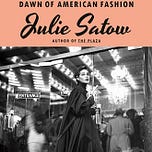The 20th century American department store: a palace of consumption where shopping meant something more than simply getting what one needed. Every major city had at least one department store where the name lives on even in an age of discounters and online buying.
New York, of course, was the nation’s business capital and main market. It was the fashion center.
Julie Satow tells the story of how women helped develop the department store and fashion in this country even though men owned the buildings because, inside the store, women ruled.
When Women Ran Fifth Avenue: Glamour and Power at the Dawn of American Fashion is a story of the 20th-century. Satow relates how Hortense Odlum turned Bonwit Teller into a multi-million-dollar success even though she had no training in the retail field. Meanwhile, Dorothy Shaver helped make it possible for American designers to leave their mark, escaping the shadow of the always-popular Parisian originals at Lord & Taylor while Geraldine Stutz reinvented the look of the modern department store at Henri Bendel in the 1960s.
These women succeeded at a time when although women were a department store’s best customers, men were in charge, noted Satow. “There were very few women bosses around when Hortense Odlum called for change in the 1930s,” she said.
Odlum objected to dresses that “shrieked cheap or whispered chic,” Satow stated. Initially, the entrenched garment industry dominated by males was dismissive. But Odlum pushed ahead for quality in women’s clothing. She also had ideas to draw men into the store such as the 721 Club within Bonwit Teller which allowed males to smoke cigars and drink whiskey while watching models exhibit the latest fashions.
Shaver not only promoted American designers but brought Art Deco to America in the late 1920s, said Satow.
Among the many stories that Satow tells in When Women Ran Fifth Avenue involves Salvador Dali, the irreverent surrealist, in 1939. Hired to do a window display at Bonwit Teller, Dali labored all night on his creation that involved a wax dummy stepping into a bathtub. Only the dummy’s blonde wig was crawling with beetles with tears of blood running down her face. Reaching out of the tub were some 100 wax arms holding mirrors. The whole theme was based on Narcissus, the Greek myth detailing the affliction of excessive vanity, said Satow.
Dali finished his window display in the early morning hours and went back to his hotel to sleep. Meanwhile Bonwit Teller opened. Complaints poured in regarding Dali’s window. Customers and passers-by found it objectionable, even obscene. As a result the store replaced Dali’s scantily clad figure with a traditional mannequin in a tailored suit.
When Dali came by in the afternoon to view his handiwork, he was enraged to see the changes made. After registering a protest with Bonwit officials, Dali returned to the window display and pushed the bathtub right through the store window, sending it and himself crashing onto the sidewalk outside. Unhurt, Dali was arrested and had to pay a fine of $500, the exact price of his commission.
The Dali incident reflects the importance of window displays in the 20th century department store. “By the 1940s, there was a retail rule of thumb that one-third of all sales could be credited to impulse purchases resulting from window displays,” noted Satow.
Among the pioneers when it came to displaying product in store windows was L. Frank Baum, the author of The Wonderful Wizard of Oz. In 1897, Baum launched The Show Window, a monthly journal that advised merchants on how to attract a customer’s attention. With the success of his Oz books in 1900, Baum left the retail world behind, said Satow.
But a department store needs more than striking window displays. Satow points to Dorothy Shaver’s work in overhauling Lord & Taylor’s advertising. Shaver hired artist Dorothy Hood to create black-and-white ads, ideal for newspapers of the day, to give the store a unique look. Ads were clutter-free with plenty of white space and minimal text. “We’re selling style, not specifics,” said Shaver.















Share this post